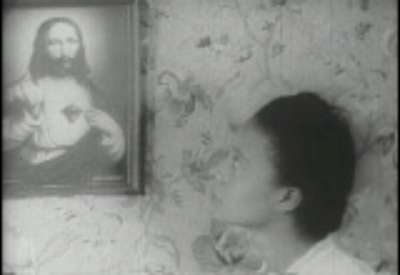
- KERA radio story:
Audio Player
- Expanded online story:
During the first half of the 20th Century, schools were the most famously segregated of our public places. But movie theaters were also divided, with black theaters showing movies now called race films.
Made by black filmmakers with black casts, race films were the independent films of their time. The films that survive provide a glimpse into black life during those days.
One of the most important is 1941’s The Blood of Jesus. It was shot in Texas by Spencer Williams, who later starred as Andy in the Amos ‘N Andy T.V. show.
The film centers on Martha, who is accidentally shot by her husband. On her death bed she must choose between the purity of heaven and the temptation of hell.
The Blood of Jesus is significant as a work of art and a historical document. Amy Turner is the head of the G. William Jones Film and Video Collection at SMU:
TURNER: “The films that Spencer Williams made during this time period tended to be shot in Texas locations – so in Dallas, in San Antonio, in Fort Worth – places like that. And so I think there is an element in Blood of Jesus that is a picture of Dallas past.”
That picture shows us the rural and religious nature of black life in Texas.
Country life symbolizes wholesomeness. The city, with its jazz and blues music, is where the devil lives. Satan drives a flatbed truck with a jazz band playing in the back.
Here’s the film’s narrator:
NARRATOR: “Almost gone are the days when peace ruled the Earth with a firm and gentle hand. When fear of God dwelt in the hearts of men and women and children.”
He’s talking about the loss of morality. But little did he know that “almost gone” were the days of his film.
The Jones Collection at SMU owns the only known 35 mm copy of The Blood of Jesus. The film came to SMU in 1983 as part of the Tyler, Texas, Black Film collection. After traveling the country in the 1940s, the print became scratched and worn, and the damage affected both the images and the soundtrack.
SMU received a $27,000 grant to preserve the film and debuted the new print this month at a conference in New York.
Matthew Bernstein, a film professor at Emory University, was one of the first to see the preserved version.
BERNSTEIN: “This film came out in 1941, so two years after Hattie McDaniel had won an Oscar for playing Mamie in Gone With the Wind and the kind of restricted roles and characterizations that African Americans would see when they came to see Hollywood films, this is a very powerful alternative.”
Ironically, as desegregation progressed, these authentic portrayals of black life faded away.
TURNER: “There was a period where there was a lot of very interesting work going on with black filmmakers, black actors, writers. And then as the venues and the demand for the things kind of shifted after desegregation, there was sort of a lull, and it took back up until the 70s to really get things moving again.”
The Blood of Jesus reminds us that black film’s history stretches back further.
BERNSTEIN: “If you think that black movies really took off with Spike Lee and She’s Gotta Have it 1986 or even if you count blaxploitation from the early 1970s – films like Shaft and Superfly – race films like The Blood of Jesus show us that African Americans were making films, and really interesting films, decades before that.”
The film was added to the National Film Registry in 1991.
Thanks to SMU, a piece of Texas and American history is safe for future generations.
WATCH ‘THE BLOOD OF JESUS’: SMU plans to hold a public screening of the preserved film later this year. Until then, you can watch the unpreserved version of The Blood of Jesus here or below:






5 Comments